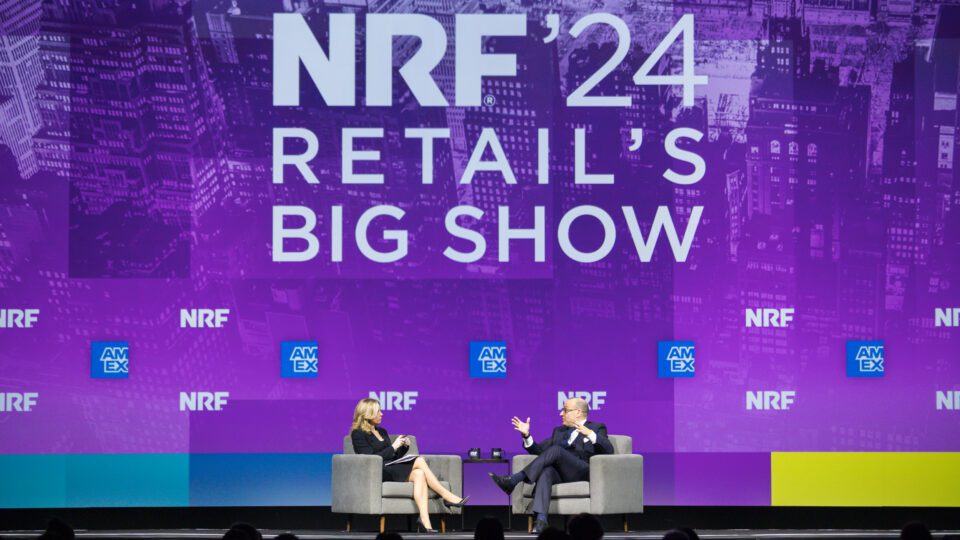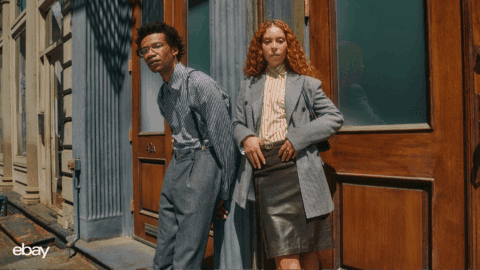Saks Fifth Avenue wasn’t always known by that name. As CEO Marc Metrick pointed out, in its early days, when it was based in NYC’s Herald Square neighborhood, the company was simply known as Saks. It wasn’t until 1924, when the store moved uptown to its now iconic location on 50th Street, that “Fifth Avenue” got tacked on.
This moment 100 years ago was one of Saks’ first big “pivots,” Metrick pointed out during a keynote presentation at the 2024 NRF Big Show. More recently, the retailer has made another big pivot, occasioned not by a physical move but by a digital one. In 2021, the company made the controversial decision to split its company into two separate entities: one a digital pure-play focused on ecommerce that now goes by just Saks (it had included the “.com” for a while to help avoid confusion); and a second that runs brick-and-mortar operations and has retained the Saks Fifth Avenue name.
“This isn’t an abandoning of what was, but an evolution,” said Metrick. “The consumer was moving online, and we knew we had to move and meet them where they wanted to be. In order to do that we had to move the center of gravity, similar to what they did back in the early 1900s. We had to invert our business model and make the online business a true center of gravity.”
On the same NRF stage (though at a different time), Barnes & Noble CEO James Daunt shared a strikingly similar story. The details are different, but the overarching trajectory is the same — the rise of ecommerce and the new shopping behaviors it prompted presented an existential threat to the business, so the company turned its strategy on its head. In the case of Barnes & Noble, this has meant transforming a homogenous national chain into something more akin to a series of local book shops, one store at a time.
Both of these brands have endured for more than 125 years. That doesn’t happen without a certain level of agility, and in both cases the key to that agility was a deep understanding of its customer, coupled with a willingness to change. It sounds simple, obvious in fact — to be successful a retailer must understand what its customers want and deliver it. But if it was easy there would be a lot more centenarian retailers out there, and the fact is, there aren’t. Going behind the scenes of these companies’ recent strategic shifts offers unique insight into how to achieve longevity in an ever-evolving world.
How Saks has Bridged the Ecommerce-Exclusivity Divide
To say that Saks’ decision to spin off its ecommerce business was controversial is an understatement. Not only does it go against one of the central tenets of modern retail — that seamlessly intertwined digital and physical channels are needed to deliver the omnichannel experience customers want. But as moderator Courtney Reagan of CNBC pointed out, making the brand accessible to anyone with an internet connection also goes against a central tenet of luxury retail: that it should be exclusive, that is, not available to the masses.
For Metrick, however, accessibility and exclusivity are not mutually exclusive: “You can still drive a feeling of exclusivity through scarcity of product, through limited distribution,” he said. “You just access them differently. I think that’s what luxury online is, it’s just a different way for folks to access.”
Saks: Growing Without Cannibalizing
And he was proud to point out that the decision has paid off for. “From 2019 — which was a high watermark for Saks, we were coming off of eight or nine quarters in a row of consecutive growth — the digital business is up over 100%; the brick-and-mortar is up double digits versus 2019. So this is working,” Metrick said. “We’ve acquired five-and-a-half times as many customers over the last couple of years than we acquired pre-pandemic, and the overall customer count is up 150% at Saks. My favorite stat is that customers who shopped the full Saks Fifth Avenue ecosystem increased 40% last year versus pre-pandemic levels. You would never have seen that if we were combined. COVID was an accelerant for sure, but it certainly didn’t give us that level of lift. And again, we haven’t seen channel shift — the stores grew and we grew.”
In particular, Metrick is excited about the number of what he likes to call “emerging” luxury shoppers (because labeling them “aspirational reeks of unqualified,” which is not how he sees them) engaging with the brand. Regardless of what you call them, Saks.com has been very successful in capturing up-and-coming shoppers who are aging into luxury, which Metrick said is crucial to the business’ health and longevity.
“Saks has almost 100% brand awareness in the U.S., so our problem isn’t awareness, it’s a matter of consideration,” Metrick said. “COVID was a great democratizer. People could just shop online, they didn’t have to feel intimidated coming into the store, they could experience luxury and really go after it.”
Why Luxury Isn’t Just for the Wealthy
“People sometimes paint the luxury consumer as this rich person, and that’s very dangerous,” Metrick added. “Anyone that’s in my position at a luxury company will get up here and say, ‘2% of our customers represent 40% or 50% of our volume.’ That’s fine, but if you’re thinking about growing through the brand and innovating, who’s filling that pipeline? At Saks we’re looking at the full luxury continuum. [At one end] there’s the ‘and’ customer: ‘I want to go on vacation and I want to buy this handbag.’ We love those people, but then there’s the ‘or’ customer: the customer who says, ‘I can go to a concert or I can buy this bag.’ We are focused on the ‘or’ customer.”
And while Metrick concentrates specifically on the Saks online business, he said that stores will always be a part of the company’s mix: “You don’t stream Hamilton. No, you go to the theater to watch it and then you stream the soundtrack on iTunes, and that’s how I look at luxury,” he said. “Luxury is always going to need a physical incarnation of what the brands are, so people can really understand and experience it. I look at the online channel as a way to express it and transact, and I think it’s a really, really strong interplay.”
In fact, even though it’s not technically part of his business, Metrick believes the Saks Fifth Avenue stores are one of the brand’s strongest competitive differentiators. “We compete with such a broad spectrum of folks — you have the online pure-plays, you’ve got the omnichannel department store, you’ve got the DTC buyers. [In some cases] our suppliers are our competitors, which actually is a pretty big conflict. But we have a very exciting proposition for the consumer that the luxury pure-plays don’t have. We have a partnership with the SFA stores where you can execute this all-channel experience, but at the same time we [at Saks.com] can act and behave and set up our KPIs and how we run our business as a pure-play. [I think we’re in a] good position as we look at the European pure-plays especially.”
And in case you were wondering, Reagan did her job and dutifully asked about the rumors of a merger with Neiman Marcus, which Metrick succinctly squashed: “It’s like Ross and Rachel, if you watch Friends,” he said. “There are lots of people that think you should get together and lots of people that don’t think you should get together, but right now we’re turning the corner into ’24 and that’s the focus.”
How Barnes & Noble is Revitalizing Nationwide by Thinking Local
It’s no secret that booksellers have struggled to adapt to the world after Amazon. And while there was much talk of the death of the independent bookshop when Amazon first launched, in recent years it’s been major chains like Barnes & Noble and Borders that have felt the pressure.
Daunt, who took the helm at Barnes & Noble in 2019, was perhaps uniquely positioned to reimagine the business in the face of these challenges. He architected the turnaround of UK bookseller Waterstones, where he is also CEO (both companies are now owned by Elliot Advisors). And before that he was an independent bookseller himself, running his shop Daunt Books, which now has nine locations (he still independently owns it).
The key to the Barnes & Noble turnaround was turning the traditional chain mentality — consistency at all costs — on its head. As Daunt pointed out, well-run independent bookstores are now doing fine, which led to the simple but at the same time revolutionary idea of letting each Barnes & Noble location operate more independently. “Our products are changing every week, every month, and we have completely different arrays across huge SKU counts, so we’re not like most other retailers,” Daunt explained. “[The idea was] to actually look at the independent example and [give each store] the breathing room to do their own thing, so they are able to resonate more effectively with the communities where they are. We did it, because we really had to.”
Gaining the ‘Freedom to Operate in Different Sizes’
The whole idea is still somewhat of an experiment for the chain, rolling out slowing across the country, and one of the first examples can be seen on Manhattan’s Upper West Side. But as Daunt pointed out, one of the big opportunities of this new approach goes beyond changing existing locations. Now, the chain “has the freedom to operate in different sizes,” which also means it can be more flexible in where it chooses to locate new stores.
“Whereas before we needed a pretty standard 20,000- to 30,000-square-foot box, because that was the norm, now suddenly, 5,000 square feet [is a possibility],” Daunt said. “And indeed, over the last six weeks we’ve opened a 35,000-square-foot store and a 6,000-square-foot store.”
So far, Daunt said the consumer response has been very positive, although he did note that “as every retailer in this room knows, the most important thing is to be lucky, and we have been quite lucky, particularly because the pandemic really threw people back into reading.”
Another thing that has aided the transformation process is being a private company again, which it has been since it was acquired by Elliot in 2019. Daunt acknowledged that not having the level of scrutiny and pressure that comes with being public can make it easier to “do difficult things.”
The one piece of the puzzle that isn’t working yet for Barnes & Noble is ecommerce, Daunt acknowledged. He thinks that ecommerce accounting for approximately 20% of sales is a natural range, but at the moment digital is accounts for only about 10% at Barnes & Noble. However, “our customers want us to be effective online,” so this will be a key area of focus for the business going forward, he added.















